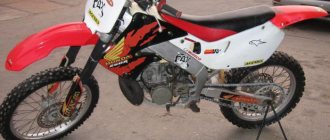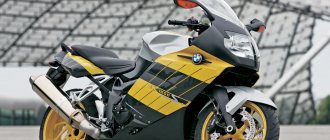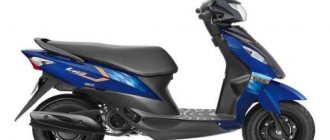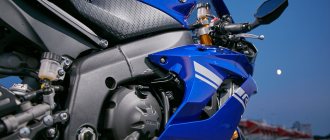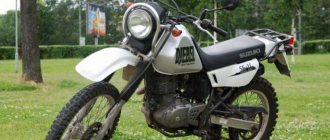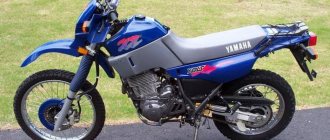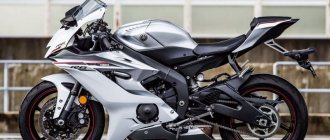This is a classic sports motorcycle, which at one time was even named the best model of the decade. Then, in the late eighties, the characteristics of the Yamaha FZR 1000 were really impressive, because even now this machine can surpass many of its classmates. What is worth at least is the fact that the bike is capable of reaching speeds of up to 270 km/h, and in other cases – even higher.
Excellent wind protection, ideal handling at high speeds, good performance at low speeds relative to other sports motorcycles - these are not all the advantages of the model. By the way, it can still be purchased on the secondary market, but this is becoming increasingly difficult, because the bike’s resource, although impressive, is not unlimited.
Motorcycle of the Decade
The superbike that brought sports design to the forefront was released in 1987 under the name Yamaha FZR 1000. Then the car had a top speed of over 250 km/h, and the 1989 modification, called the motorcycle of the decade, could accelerate to 100 km/h in less than 3 s. Its maximum speed exceeded 270 km/h. With such characteristics, any bike would be in great demand, so production continued.
In 1989, the manufacturer improved the performance of the Yamaha FZR 1000 by increasing the engine displacement to 1002 cm3 and adding electronic exhaust valve control. The latter's shortened name, EXUP, became the motorcycle's well-known nickname. Despite the increase in engine displacement, it has become more compact and 8 mm shorter due to a change in the inclination of the cylinders to 35°. The angles and sizes of the valves have changed, as well as the timing of the camshaft. Larger carburetors helped improve performance, the crankshaft was strengthened, and countless other changes were made. The system was replenished with useful power at mid-range speeds, and the engine's horsepower increased to 145.
A unique feature that appeared on models beginning in 1989, known as EXUP, was a servo motor that controlled the exhaust valve. This made it possible to increase the diameter of the exhaust pipe for better fuel supply at high engine speeds, as well as limit it at low speeds. The chassis was also improved and the bike's handling improved, making the EXUP system popular with other Japanese superbikes.
The 1989 frame (now called Delta Box 2) used the engine as a stressed member. Gone are the downpipes, replaced by a secure mount of the cylinder head to the top of the frame. This design became the basis for the radical chassis layout of the YZF R1 almost 10 years later. For 1987, the 18-inch rear wheel was replaced by a 5.5x17-inch one, and the 17-inch front wheel was widened to 89 mm. The standard fork leg diameter has increased by 2 mm to 43 mm. Other changes were more subtle, but no less valuable: the front and rear axles and swingarm pivot bolt were increased in diameter and made hollow. This strengthened them and increased stability under the loads of sharp turns. The Pirelli MP7S tires specially designed for this model have been called the best ever installed on a motorcycle, and according to user reviews, there is no reason to disagree with this. The 1987 FZR was equipped with Japanese-made Dunlop rubber, which had less grip than an eraser and had about the same lifespan. Users who have tried tires from various manufacturers, radial and diagonal, have not found anything better than Pirelli, except for the fabulously expensive, GP-quality, English-made Dunlop D364. Owners warn that the motorcycle is very sensitive to tire wear and tends to stand on end if the rear tread is worn out by more than half.
But the improvements don't stop there. In 1991, the package was modified to include the Yamaha FZR 1000 RU, featuring steeper inverted forks. Final improvements were made in 1991 and 1994, and then in 1996 the FZR1000 was replaced by the YZF 1000 Thunder Ace.
Comfort Yamaha YXZ1000R
Yamaha will provide improved comfort for the YXZ1000R ATV in 2019 - Rider and passengers can now enjoy a more spacious and cooler cabin
The design of the new Yamaha YXZ1000R has been redesigned in such a way that both the driver and passengers feel as comfortable as possible when riding on any terrain. A new larger radiator is installed behind the seats, which at the same time not only eliminates excess heat in the cabin, but also eliminates the possibility of clogging the holes when driving in mud. Multiple inlet openings ensure constant air flow even when the platform is loaded.
The driver and passengers feel freer in the cabin due to the fact that the seats are now located lower and the roof structure has been redesigned. It is also now easier to get in and out of the car. Thanks to the new roof and more aggressive body, the ATV is difficult to miss in any terrain.
The ATV's optimized suspension settings provide increased ground clearance and a smoother ride, even in the toughest conditions. New FOX RC2 shocks with increased spring rate and new internals now have dual springs and adjustable crossmembers. 26-inch front shocks protrude from the top of the front plastic and provide 405mm of travel, while massive rear shocks handle 425mm of travel.
Yamaha YXZ1000R and YXZ1000R SS ATVs in Team Yamaha Blue color
First 4-stroke
The Yamaha FZR-1000 Genesis is a significant model that marked the transition from 2-stroke to 4-stroke sports motorcycles. This change gave rise to a new generation of high-performance big bikes that incorporated racing technology. The first Genesis was unveiled to the public at the IFMA motorcycle show in Cologne (Germany) on September 18, 1986 and continued the success of its predecessors, the RD 350 and RD 500.
Chassis and brakes
The diagonal frame, also called Deltabox, is made of aluminum, which makes the model somewhat lighter. The suspension here is truly sporty and stiff, making the FZR 1000 completely unsuitable for any rough roads.
The brakes here are disc, in front, as usual, there is not one, but a pair of discs, and the calipers are not two-piston, but four-piston. The exterior of the car as a whole looks very harmonious. However, no matter how comfortable the motorcycle may seem, sitting on the FZR 1000 will somehow get tiring after a couple of hours, and this is already a cost for the sports category of bikes as a whole.
Exterior
In 1989, Yamaha redesigned its largest sports bike, and it was completely transformed. The new sportbike felt smaller, lighter and lower, but the radical improvements showed up in the ride. The motorcycle seat has been redesigned and has become wider, more ergonomic and more comfortable.
In the opinion of many, the Yamaha FZR 1000, which appeared in 1987, was the best available model with an engine displacement of 1000 cm3. There were no major changes to the exterior design, with the exception of a headlight change in 1991 and 1992 and the addition of a 4-piston brake caliper in 1989. The air intake system was improved for the 1991 and 1992 versions. During the final years of production, the FZR was reverted to the original model's dual headlight design, which was retained until production ended in 1996.
YXZ1000R Reliability
Superior durability and quality for a confident ride and hassle-free ownership.
Yamaha ATVs are designed, built and tested in real world conditions. The YXZ1000R is a true example of the durability and reliability that off-road enthusiasts have come to expect from Yamaha.
The Yamaha YXZ1000R and YXZ1000R SS will be available in Team Yamaha Blue and Graphite. There is also a special edition of the YXZ1000R SS (SE) model in white with color-matched interior, beadlock tires, hardtop and other premium components.
Characteristics of Yamaha FZR 1000 Genesis
The power source of the motorcycle is a 989 cc water-cooled engine. cm. It had forward inclined cylinders and DOHC. The 20-valve format was introduced in the FZ750 two years earlier. The engine developed 130 hp. With. at a rotation speed of 10,000 rpm, but in 1989 the manufacturer increased the engine displacement to 1002 cm3, while the unit reached a power of 145 hp. With. at 10,000 rpm. He gave the name to the new modification EXUP. The system, first used on 4-stroke engines, increased performance and torque. The Power Limit Exhaust Valve is an exhaust gas control system that is still used on the YZF R1 today in an improved form. It allows you to regulate the flow of exhaust gases depending on engine speed.
Specifications
The technical specifications of the Yamaha FZR 1000 are as follows:
- engine displacement: 1002 cm3;
- engine type: in-line 4-cylinder;
- number of cycles: 4;
- power: 145 l. With. (105.8 kW) at 10 thousand rpm;
- number of valves per cylinder: 5;
- starter: electric;
- transmission: 5-speed;
- weight without fuel: 214 kg;
- seat height: 775 mm;
- front brakes: double disc;
- rear brakes: single disc;
- power to weight ratio: 0.6776 hp. s./kg
- acceleration to 100 km/h: 2.9 s;
- Max. speed: 275 km/h.
Dimensions and weight
Without fuel, the FZR 1000 weighs 215 kg, and with it - 235 kg. The fuel tank capacity is 19 liters, which is not bad, but do not forget that at high speeds, about 10 liters can easily be consumed per hundred kilometers. However, this is not a motorcycle for long trips. The seat height is only 775 mm, which is not much within the class, but for a short person who cannot easily reach the ground with his feet, it will not be easy, because the center of gravity of the FZR 1000 is high.
Performance evaluation
The Yamaha FZR 1000 superbike is described by owner reviews as perfectly balanced and with enormous power. The chassis is quite capable of remaining stable under full engine load, making for a more enjoyable ride. According to user reviews, what they like most about it is its extremely light weight and maneuverability. The 45-degree cylinders and relatively low seat height make the bike feel lighter than the new R1, despite being 23kg heavier. The machine is very easy to handle and has extremely satisfactory acceleration. The FZR-1000 rider becomes one with the motorcycle for an unforgettable riding experience. On other modern sports superbikes you can only sit astride, and this is not so comfortable. But what moves fast needs to be stopped just as quickly, and the FZR-1000 has no problem with that. A durable motorcycle braking system will do the job reliably every time. The engine starts screaming when reaching 7000 rpm, and no moving objects on the road can overtake it at full power. Yamaha's 20-valve inline-4 engine is one of the most reliable engines ever made, so you can hit the road with confidence.
Price
Owners of motorcycles of this model take very good care of them, so it will not be difficult to find a copy that will look and ride great. If the owner has a complete service history for the car and the mileage seems satisfactory, then it is worth considering purchasing it. According to the advice of the owners, you should also make sure that the tires are in good condition, because on sportbikes they are not so durable and are not cheap. Yamaha FZR 1000 1995–1996 issue costs about 4–4.3 thousand US dollars, 1987-1988. – somewhere around $2.5 thousand, but it’s worth buying if its care and functioning are completely satisfactory.
